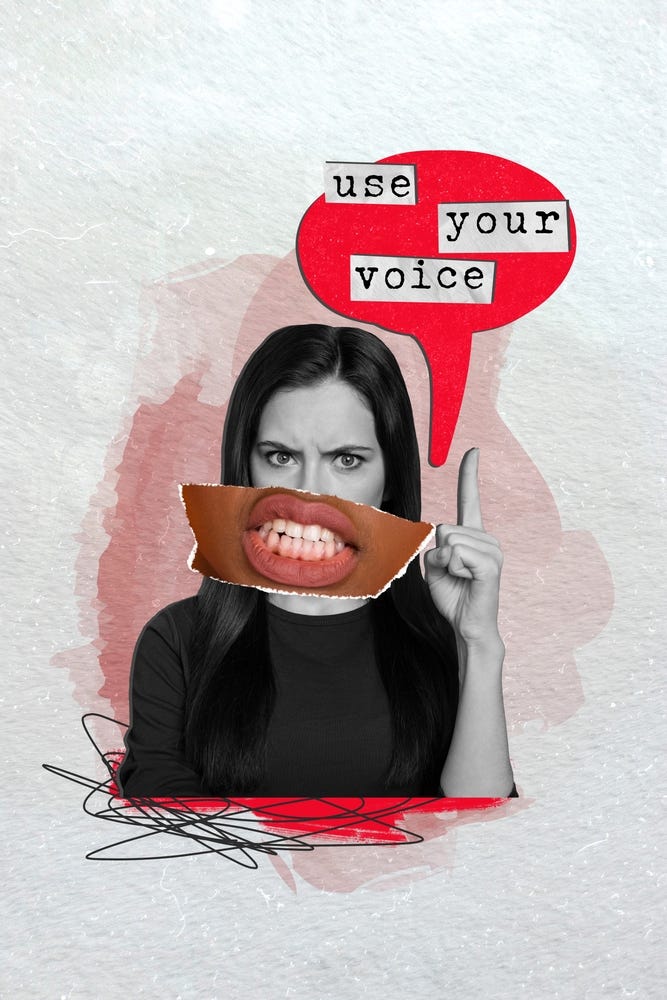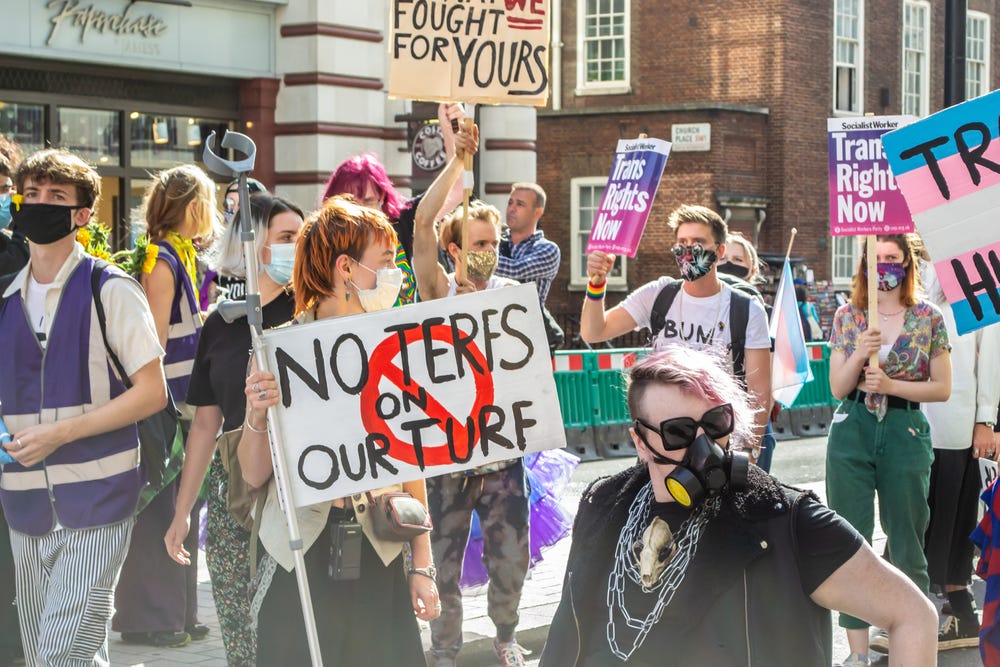E-Pluribus | July 11, 2023
Art and politics are often a bad mix; the New York Times on the New York Times; and what's a TERF, anyway?
A round-up of the latest and best writing and musings on the rise of illiberalism in the public discourse:
Alice Gribbin: Why Good Politics Makes for Bad Art
Given the reputation of politics these days, if “all art is political” then art is in a lot of trouble. Alice Gribbin takes on this notion at Tablet Magazine, arguing that while politics and art can mix, there are plenty of reasons to just let art be art.
“All art is political,” a notion with which we are bludgeoned, derives from two facts of formidable substance: that (i) artworks are produced by and exist for people, and that (ii) wherever there are people, there are politics. Gut bacteria also are present wherever there are people, though are we advised less frequently to seek in poems and sculptures hard truths about the microbiome. Toni Morrison, a superlative artist, endorsed the notion in the way it is most typically pronounced. From a 2008 interview:
“Are you really telling me that Shakespeare and Aeschylus weren’t writing about kings? All good art is political! There is none that isn’t. And the ones that try hard not to be political are political by saying, “We love the status quo.” We’ve just dirtied the word “politics,” made it sound like it’s unpatriotic or something. ... My point is that it has to be both: beautiful and political at the same time. I’m not interested in art that is not in the world.”
By “art ... in the world,” I take her to mean art concerned with social relations, which regretfully fails to encompass all sorts of works of both nonrepresentational and nonnarrative art. It is to the detriment of all who revere Morrison that the interviewer did not follow up with the question of whether Monet’s waterlilies, as examples of “good art,” are political. Possibly Morrison did not care for those paintings. Monet’s plants had been imported from Egypt and South America; maybe, though I can hardly imagine it, she would have something to say about the politics of the late 19th-century botanical trade.
[ . . . ]
With important artists on record stating that all good art is political, naturally people throughout the culture will themselves insist on the notion in an effort to have them and their output appear more serious than they are. When presented as forthrightly political, commercial products transmogrify, instantly, into works of art. Here is how the entertainer Lin-Manuel Miranda opened “What Art Can Do,” a 2019 magazine article: “All art is political. ... Art lives in the world, and we exist in the world, and we cannot create honest work about the world in which we live without reflecting it.” He goes on, in no less bracing prose, to explain that his forthcoming film is about immigrants, who indeed live in the world, and that some immigrants have been demonized. Present political conditions, Miranda writes, have made his story a “radical narrative.” Today, “for some, considering an immigrant a human being is a radical political act.”
No doubt emptier statements than this have been printed in The Atlantic, but its meaninglessness in the context of contemporary American life is worth observing. It is a farce to imagine that artworks about the plight of immigrants in any way help attend to the material problems of how the nation’s immigration and asylum systems are to be run. The number of people worldwide wanting to move to the United States was 160 million on last count. Should all be welcome here? May they arrive tomorrow? What resources will be apportioned to support the poor, the helpless, and the sick among them? Will working class wages be affected, and do we care? Are there jobs and schools and housing enough for the new arrivals? If there are not, what is to be done so that each immigrant is not merely considered a human being, terribly radical though this act is, but capable of living decently as one? Artworks sold as politically radical allow the purchasing public to indulge their concerns in the bloodless realm of abstraction. Along with a ticket to one of Miranda’s productions, they buy the lie that to attend is the height of civic responsibility.
Read the whole thing.
Steve Hayes and Sarah Isgur with A.G. Sulzberger: ‘Independent Journalism Is a Good Fit for Any Moment, but Particularly This Moment’
The New York Times, being the huge target that it is, often serves as a punching bag for both the right and left. The Dispatch’s Steve Hayes and Sarah Isgur sat down with A.G. Sulzberger, the latest member of the Sulzberger clan to head the paper, to talk about how he sees the role of the old grey lady in today’s media environment.
Sulzberger: [My May 2023 essay in Columbia Journalism Review is] basically making a case for a vision of independent journalism that I believe in. And that has a long history at this institution. My great-great-grandfather writes the phrase in his first day as publisher: to give the news impartially, without fear or favor, regardless of party, or sect, or interests involved. And that vision, which then was quite radical, in the era of the partisan press, then became quite mainstream. Right? Sort of, through most of the 20th century and into this century, is more fiercely contested at any point in my lifetime. It’s also harder than at any point in my lifetime. Just the act and process of independent journalism is harder than any point in my lifetime. And I talk to reporters every day who feel like, if they’re going to cover controversial topics, or write things that certain groups don’t want to hear, that they basically feel like they have to wake up and put on a suit of battle armor, to prepare themselves for the harassment and trolling and threatening, and, you know, efforts to, you know, damage or destroy their reputations. Which I know you at The Dispatch are aware of, right, a lot of your folks have been really serious recipients of those campaigns. So it’s more contested than ever, it’s harder than ever, I also really believe it’s more important than ever. It’s become clear to me that it’s not intuitive to the public why. And I felt someone should make a case for it. And make a case that doesn’t just assume why independent journalism is a good fit for any moment, but particularly this moment of misinformation and polarization and tribalism, and in my view, is actually the antidote to this moment. So that’s why I wrote the essay. As for why I talked about independence, this is sort of an academic, esoteric topic that us journalists think a lot about.
[ . . . ]
I think [journalistic independence is] central to democracy, but maybe not one that the average voter feels grounded to then. So why not choose the word that most of the debate has sort of historically revolved around—this word “objectivity”? So for one, independence has more of a history at the New York Times, right? It’s actually the word my great-great grandfather gravitated towards in describing his vision for the Times, and it’s actually the only word he uses twice in his direction to the family about how the Times should be led into the future. But I actually think there’s also just a more practical reason why, which is “objectivity” is, for better or worse, one of those words that just inspires people to pull out the dictionary. And it inspires these very academic debates over: Can a person be objective? Or is it the process that’s objective? And beyond even that, I think it’s incomplete. Right? I think independence, you know, captures objectivity, captures neutrality, it captures impartiality and fairness, right? I think there’s a lot of words that feel core to me about the journalistic posture that we want to see that ladder up into independence. And independence is a colloquial word. It’s a word that when you say it to a person, they know what you’re promising them.
Read it all.
Kara Dansky: What is a TERF and Why it Matters in Today’s Political Climate
First published a year ago in the Washington Examiner, a version of this essay explaining what a “TERF” is by feminist Kara Dansky appears this week at the website of the Foundation Against Intolerance & Racism. If you’ve read anything about J.K. Rowling in the past few years, this term was probably included, but not always fully explained. As one often tagged with the label, Dansky gives her perspective.
But what is a TERF? I want to clear up some misconceptions about what the term means and about who we actually are as a political movement.
It is not entirely clear when the term was first coined, but it originally stood for “Trans Exclusionary Radical Feminist.” Many women who are targeted with the term (which is often accompanied by threats of rape and torturous death – just ask author J.K. Rowling) take offense at it. But others have embraced it.
In recent years, gender ideologues have expanded the TERF label to apply to anyone who understands that biological sex is grounded in material reality. This is inaccurate too, because many people who understand this truth are not radical feminists. Some are conservatives. Some are liberals. In fact, most people understand that sex is grounded in reality, but they’re not necessarily radical feminists.
Finally, it is common to characterize TERFs as being essentially conservative or “right-wing reactionaries.” This is not accurate either. Radical feminists generally come from the political Left and typically have very traditional liberal values. Most American radical feminists are either Democrats or Greens, or they have become independents in the past few years because they are tired of the Democratic Party’s embrace of “gender identity” (among other things). I know of no radical feminists who are Republicans and of no Republicans who claim to be radical feminists.
So what are we, exactly? In short, a TERF is a radical feminist leftist who recognizes the material reality of sex.
[ . . . ]
For TERFs, the issue comes down to this: Women as a class have always been oppressed by men as a class (regardless of the benign behaviors of any individual men) on the basis of sex and we are all quite angry about it. There is a reason that suffragists had to fight for the right to vote after being denied the franchise for centuries, and that countless men and institutions fought hard to stop them. There is a reason that all over the world, men beat, rape, torture, and murder women and girls at astronomical rates. There is a reason that lesbians are routinely targeted for harassment or worse. There is a reason that men used to burn women for allegedly engaging in witchcraft. It was not on the basis of “identity” – no one bothered to ask women which pronouns they preferred. It was on the basis of sex. And now much of the “gender identity” movement denies that sex even exists or that it might matter.
Read it all here.
Around Twitter
Jonathan Kay gets to the heart of the “female-identifying filmmaker” babble from a Canada Council for the Arts award winner:
Well, innocent until proven guilty had a good run! Megan McArdle highlights the disturbing view of the rights of the accused at Minnesota’s Macalester College:
And finally, former President Obama thinks that private sector content moderation needs a helping hand from the government (click for video):










